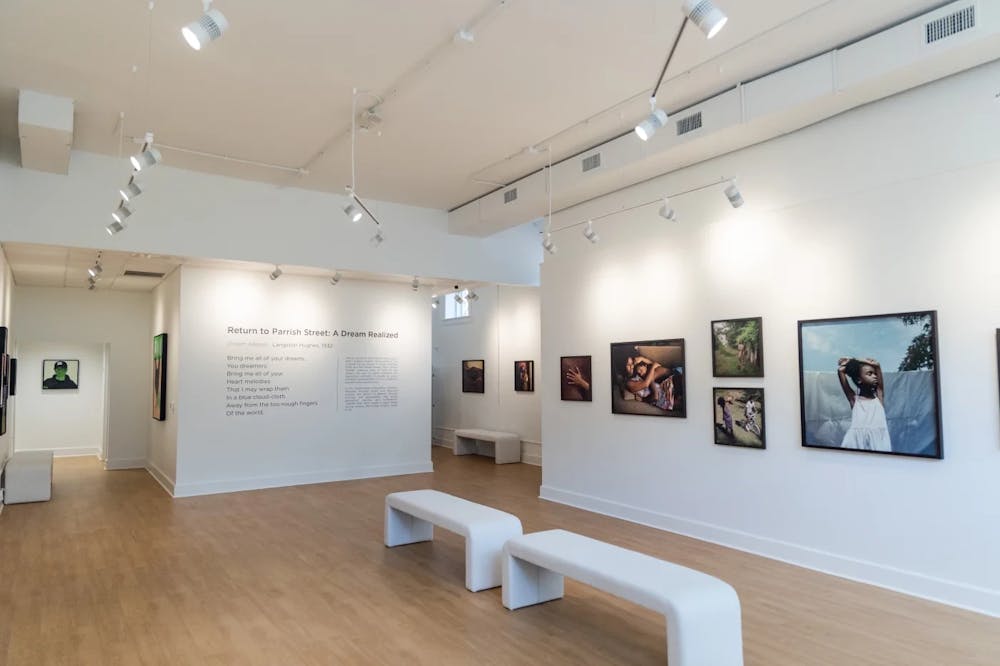Located in Durham’s City Center District, the newly-opened Ella West Gallery lies inside an old brick warehouse. Within this gallery, the exhibition "Return to Parrish Street: A Dream Realized" showcases and honors Black artistic expression.
This purpose lines up perfectly with the vision of Ella West Gallery founder Linda Shropshire, who wanted to create a fine art space that recognized and celebrated the diversity in the Durham community. Her dual passions for art and creating a space for Black artists is illuminated throughout the gallery, which features many works by North Carolina artists.
The gallery is located in what was once Durham’s “Black Wall Street,” the home to a variety of Black-owned businesses during the late 1800s and early 1900s. Once called the “mecca of the Black South,” this area suffered greatly from desegregation and Urban Renewal, a government initiative that resulted in the construction of Durham Freeway 147 through the heart of the district.
The building is also a part of “Black Wall Street’s” history, as it was once home to the printing presses of The Durham Reformer, a 1920s-era Black newspaper. By opening the gallery, Shropshire recognizes just how important it is to remember and take pride in what was “Black Wall Street.”
“Return to Parrish Street: A Dream Revisited” is dedicated to Durham native and artist Ernie Barnes, displaying several of the late artist's paintings that visually show his life experiences from Durham to Los Angeles.
Upon first entering, the title of the gallery can be seen on the back wall, its black letters standing out against the wall’s white paint. Next to the title is “The Dream Keeper,” a poem by Harlem Renaissance poet Langston Hughes, and an explanation of why that poem was chosen.
The aforementioned poem and “A Dream Deferred”, another of Hughes’s poems, provide the inspiration for the exhibition title. The poems embody the “aspirational elements of dreams as goals.” Showcasing work by Clarence Heyward, Kennedi Carter and Ransom, the exhibit is meant to “traverse the terrain of dreams through portraits and photography that probe perception, identity, and vulnerability.”
On one side of the exhibit, Clarence Heyward’s works are displayed under “Painting His Truth.” In these works, Heyward portrays his subjects as “emissaries of lived truth in his exploration of identity and Blackness.”
“George,” one of Heyward’s paintings, shows George Floyd with his head positioned sideways facing the viewer. Behind his head is a canvas that’s entirely white with the exception of a plain black strip at the bottom. The whiteness of the painting dominates over George Floyd and the black strip, visually illustrating George Floyd’s death and the oppression of the Black community. In his more recent work, Heyward seems to play with color, with the portraits of his family, friends and colleagues all having a green skin tone. This reflects the author’s fascination with the use of “green screens” in film and media. Giving his subjects a green skin tone also lets Heyward address how Black people are portrayed in the media and encourage viewers to “examine how their own perceptions distort reality and shape identity.”
Next to Heyward’s work is Ransom’s artwork. Centering on his African-American lineage, Ransom traces his story back to sharecroppers who migrated to cities in the northeastern United States. Ransom plays on this idea of “making something out of nothing” by combining acrylic paint with found, made and purchased papers. He also highlights his upbringing in soul and R&B by using symbols in his piece to showcase the rhythmic properties of music. Each of Ransom’s works uses vivid and bold colors and include a portrait of one or more Black individuals.
The rest of the exhibit is full of works by photographer Kennedi Carter. Through images, she “creates lush images that celebrate beauty, the body, and Blackness.” Carter uses her photography skills to capture some of life’s unknown, unexpected and often overlooked moments. In one of her pieces, a little Black girl is shown wearing a white dress with her arms crossed over her head, a white sheet behind her and the blue sky overhead. Her eyes are closed as she appears to soak up and enjoy the sunlight.
Carter’s work also captures the relationship between mother and child, with her including many pictures of young children being held by a mother figure. This helps shed light on how we often overlook the relationship between a Black mother figure and a child.
Overall, I believe the exhibit does a great job of recognizing the significance of Black art culture to Durham. The most rewarding part about this gallery is its focus on creating a space for marginalized communities. It’s not too often that you will find a gallery oriented in this way which sets it apart from the rest.
“A Return to Parrish Street: A Dream Revisited” opened on Aug. 19 and remained on view until Oct. 21.
Get The Chronicle straight to your inbox
Signup for our weekly newsletter. Cancel at any time.

Kerria Weaver is a second-year master’s student in the Graduate Liberal Studies program and an associate news editor of The Chronicle’s 119th volume.

